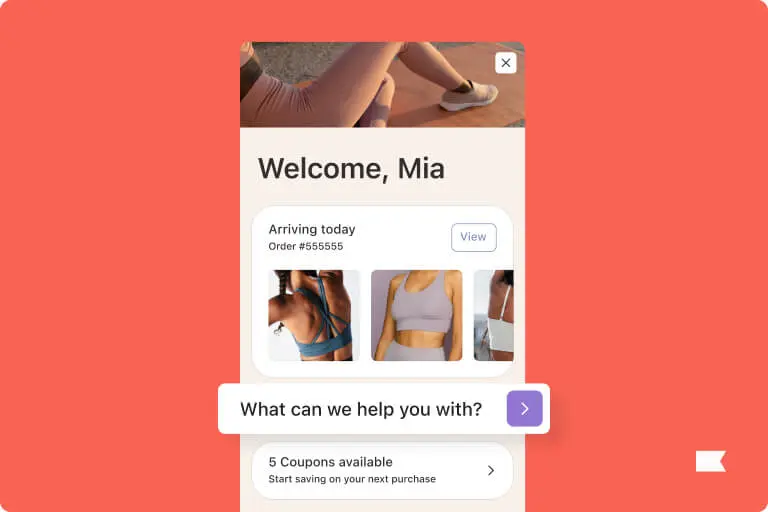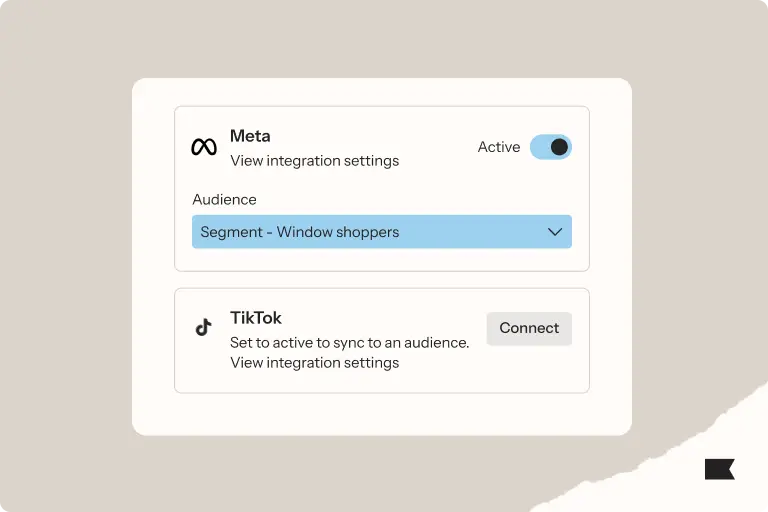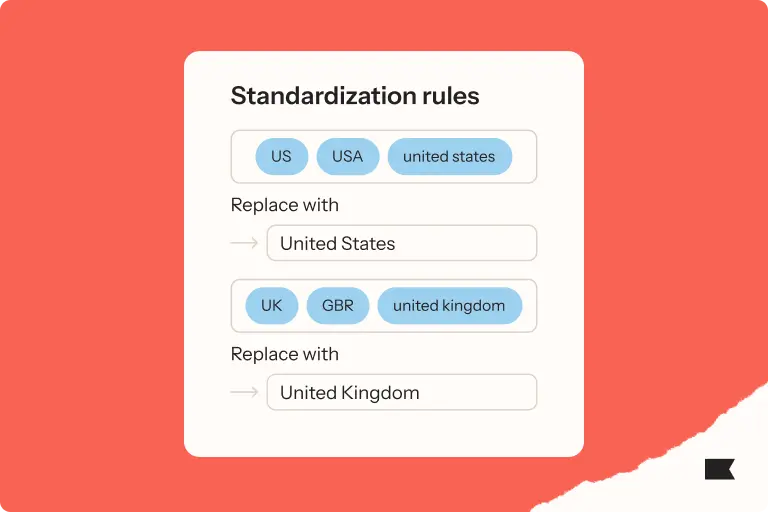5 ways to use Klaviyo data to enhance the customer journey—and retain more customers

Imagine you’re working in a brick-and-mortar store.
A shopper walks through your door. You can tell they’re in a good mood by the lightness in their step, the smile on their face, and their openness when you engage them in conversation.
Another person walks in. They’re frowning, distracted.
The first person fills their cart with your products, while the second person wanders aimlessly.
Who would you focus your sales effort on?
There’s no wrong answer, but in either case, you would be relationship building. You might ask them how their day is going and share in their joy, or empathize with their pain. You might point them toward the products that would be the best fit.
Whatever happened in this person-to-person interaction would be likely to be a deciding factor in whether the shopper would return to your store.
As head of email and retention at FABO, a holistic growth partner for ecommerce brands working in the lifestyle and apparel industry, I know all too well that brands can’t read a recipient’s mood via email.
But that doesn’t mean we can’t build relationships via that channel. Treating the inbox as simply a sales channel ignores how much trust and value can be cultivated through thoughtful communication.
Email is about experiences, not just transactions
I’ve noticed a common trend in the Danish market and beyond: most businesses see email as a way to push promotions. Brands routinely flush resources into channels like TikTok and Meta for fast customer acquisition, but often overlook retention via email.
And without a strategy for existing customers, marketers face ongoing churn: a never-ending cycle of hustling to acquire new leads instead of retaining the customers they already have.
Instead, they could be creating positive, memorable experiences in the inbox.
In the long run—especially when facing economic uncertainty—you need more than impressive performance metrics. You need to build long-term relationships and increase lifetime value (LTV).
And consistent personality in communication is essential for strong retention.
3 guiding questions when considering your inbox persona
When I start working with a new client, I always begin with 3 questions:
1. Who do you want to be in the inbox?
Picture your brand as a person walking into a room. What energy would you bring? Are you the jolly person who’s super excited to see everyone? Or maybe you’re the cool, laid-back friend who says “Let me know if you need me.”
Whatever your persona is, if you can’t define it clearly, your emails won’t connect.
But if you take the time to define your brand personality and keep it top of mind with everything you do, it makes your emails so much stronger.
At FABO, we build a persona for each brand with just one sentence that sums them up, and that becomes the North Star for all our communications. For example, we might name a persona “The stylish big sister”:she always has fashion advice and stays up to date on all trends.
2. Why?
The second question really is that simple. Why do you want to be that person in the inbox?
A lot of brands never think about why they want a certain tone of voice, or what they’re hoping to accomplish with that personality. There’s often a gap between who they think they are and how they come across in their emails.
Asking a simple “Why?” helps people slow down and think it through. Often, if their answer to the second question opens a new can of worms, we return to question one and rethink the persona.
3. How can you dig deeper?
The third question I ask is always dynamic, based on how the brand answers the first and second questions. I take something that they mention and push them to:
- Dig deeper.
- Clarify something.
- Make the persona actionable in some way.
Usually, by the end of this exercise, we have real clarity on what kind of experience we want to create for the brand’s subscribers.
5 ways to use Klaviyo data to enhance the customer journey
Once we’ve established a brand’s persona, we think beyond standard personalization.
It has to go beyond just using someone’s first name. We recommend using playful language or gamifying offers on forms to help recapture unengaged subscribers. And when the on-site tone matches the one in the inbox, you create a unified brand presence.
One of the best tools to enhance your customer journey is Klaviyo. Here are 5 ways to add personalized touchpoints to your customer journey:
1. Use zero- and first-party data to personalize content
Making the most of zero- and first-party data is a crucial part of how you communicate to your audience. By asking just a few strategic questions during sign-up (for example, style preferences, interests, or experience level), you can diversify not just what you say, but how you say it.
For example, if a subscriber selects “new to cooking,” your welcome flow can feature a warm, supportive sender personality that reassures and encourages. Someone who selects “pro in the kitchen,” on the other hand, might get a more confident, high-energy tone.
In this way, you meet the audience at their level, delivering more value. And you can grow with them and meet them at the next level, too.
“A benefit of collecting zero-party data is that it can help increase the volume of people entering a subscriber list,” says Ben Zettler, founder of Zettler Digital, a results-driven agency specializing in performance marketing, retention, and website optimization.
A benefit of collecting zero-party data is that it can help increase the volume of people entering a subscriber list.
Zettler Digital and his team have consistently seen higher form submission rates when brands prompt shoppers with a multi-step form containing a question.
Diane Noth, senior retention marketing manager at jewelry brand Mint & Lily, sees the same.
“We’ve successfully captured customers’ birth months through our opt-in flow, resulting in an improved opt-in rate by adding this additional field,” Noth says. “Each month, we target these segments with a birthday gift campaign: a $20 gift card available only during their birth month to drive purchases.”
We’ve successfully captured customers’ birth months through our opt-in flow, resulting in an improved opt-in rate by adding this additional field.
2. Use behavioral data and predictive analytics to show different CTAs
Not all your subscribers are mature enough in the customer journey for the standard “Shop now” call to action (CTA). When you use that uniformly, you might see lower click rates.
But if you identify and map engagement properties to your audience, you can use show/hide logic to determine who gets certain CTAs. This allows us to build our several personalized variations in one email instead of building multiple.
For example, you can show “Shop now” for segments that are showing purchase behavior, but show “Get inspired now” for those who might need a little extra convincing.
| High-intent segments | Low-intent/browsing segments | Churning customers | |
| Tone | Confident, action-oriented | Curious, friendly | Empathetic, conversational |
| CTA | “Shop now” | “Get inspired” “Take a closer look” | “Still thinking about it?” “Let us show you something new” |
3. Use dynamic content blocks + segmentation to let your brand voice grow with your audience
As your subscribers move through your customer journey, your sender personality shouldn’t stay static. That’s exactly why you should use dynamic content blocks and segmentation to keep your brand voice relevant to your audience as the relationship develops.
Consider this: you know the customer’s behavior. But what if you responded like a real person would? By mapping engagement signals (for example, frequent browsing without buying, high open rates but low clicks, recent churn), your sender personality can shift in tone—not just content—to match the subscriber’s emotional state.
Think of it as mood-matching:
- Passive browsers? Be calm and curious.
- Engaged but hesitant? Use a reassuring and confident tone.
- Recently churned? Be empathetic and light.
Once you’ve mapped out the different stages, it all comes down to setting up the blocks in your emails and SMS.
Noth uses Klaviyo’s dynamic product blocks to suggest products people are most likely to buy, based on purchase and viewing history.
“To maximize engagement, I send reminder emails throughout the month featuring the gift, personalized messaging tied to their birthstone, and the meaning behind their birth month,” she says.
These campaigns consistently perform as one of Mint & Lily’s top monthly initiatives, generating at least $0.20 in revenue per recipient, according to Noth.
They’re also testing a new variation: sending reminders for loved ones’ upcoming birthdays to see if this drives similar results.
Personalization pro tip: If you’re up for a little more work—and payoff—use your segments to display targeted forms for an improved on-site experience.
4. Use RFM analysis to personalize on a granular level
There are a few different ways to use recency, frequency, and monetary value (RFM) analysis to further personalize your marketing.
Zac Fromson, co-founder of Lilo Social, a full-funnel ecommerce growth agency, recommends starting with Klaviyo’s customer analytics to determine each customer’s RFM value.
You can then create dynamic segments such as:
| Segment | Included in segment |
| Champions | High R, F, + M Your best customers |
| At-risk | High M + F, but low R Big spenders who haven’t returned |
| New customers | High R, but low F + M Just made their first purchase |
| Loyal customers | High F, moderate to high M Frequent buyers |
| Potential loyalists | Moderate R + F On their way to becoming loyal |
Then, once you’ve got your segments organized according to RFM, send personalized email flows for each segment, such as:
| Segment | Sending recommendations | Personalization recommendations |
| Champions | Early access to sales VIP product launches Referral program invites | Give credit along with a reward, such as: “You’ve helped shape our brand—here’s your sneak peek.” |
| At-risk customers | Re-engagement emails | Personalize product recommendations based on past purchases and an incentive. Use subject lines such as “We miss you [First Name]—here’s 15% off.” |
| New customers | A welcome series highlighting product value, how-to content, and social proof | Include cross-sell options based on what someone just purchased. |
| Loyal customers | Loyalty rewards Surprise gifts Exclusive content | Trigger emails that say “You’ve bought [X times]—you’re a true fan.” |
| Potential loyalists | Educational content Personalized product bundles Up-sell campaigns | Incentivize another purchase with limited-time offers or bundle discounts. |
5. Blend RFM triggers with zero- or first-party profile properties
Lauren Arendt, growth marketing manager at sustainable water bottle brand HydroFlask, recommends relying on RFM to personalize the timing of your win-back flow.
“Trigger your win-back to send when a customer moves down an RFM group rung,” she suggests. “Then, depending on which group they started in and recently moved to, tailor your messaging accordingly.”
For instance, if someone drops all the way from the “Champion” segment to “Inactive,” that warrants a stronger message.
“At HydroFlask, we add a little brand personality by layering in loyalty tier and point status,” Arendt says. “This helps us encourage customers to come back to our brand by completing fun activities that can earn them a reward they can redeem the next time they buy.”
Trigger your win-back to send when a customer moves down an RFM rung, then tailor your messaging accordingly.
Measure, refine, and grow
The most effective personalization strategies rely on ongoing measurement.
No matter which personalization tactics you’re using, you’ll want to track your metrics. Fromson recommends that brands:
- Track conversion rates per segment.
- Measure email performance (open, click, and purchase rates).
- Monitor LTV changes across RFM segments.
“Then, continuously refine each flow based on what drives engagement and revenue,” Fromson says.
Ready to make sure you’re communicating the right message to the right people at the right time?

Related content

Discover how ecommerce personalisation enhances customer experiences and boosts revenue with real examples and proven strategies.

Discover how one brand used Klaviyo’s Meta integration to build high-intent audiences, lower CPA, and drive 2x conversions through smarter ad targeting.

Learn how to use Klaviyo’s advanced CDP to drive more revenue this BFCM—from real-time personalization and enriched profiles to warehouse syncs, alerts, and custom segmentation.